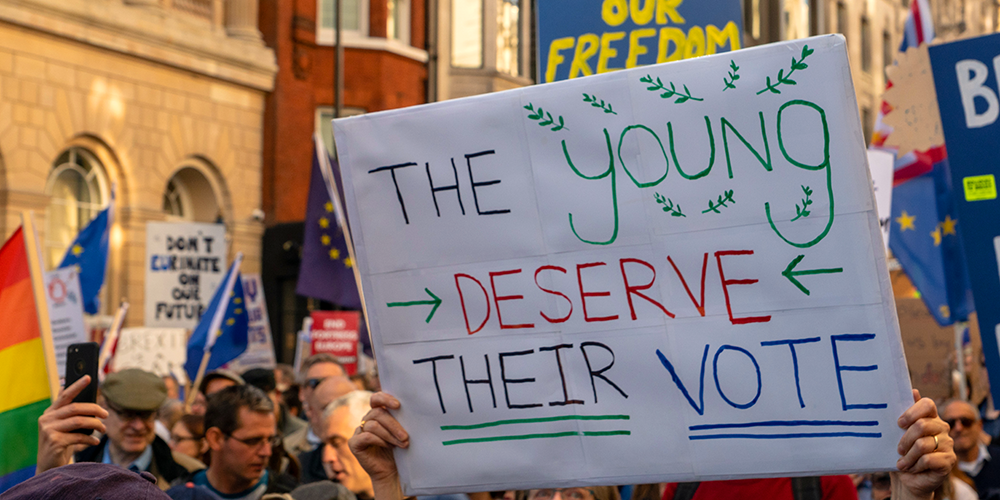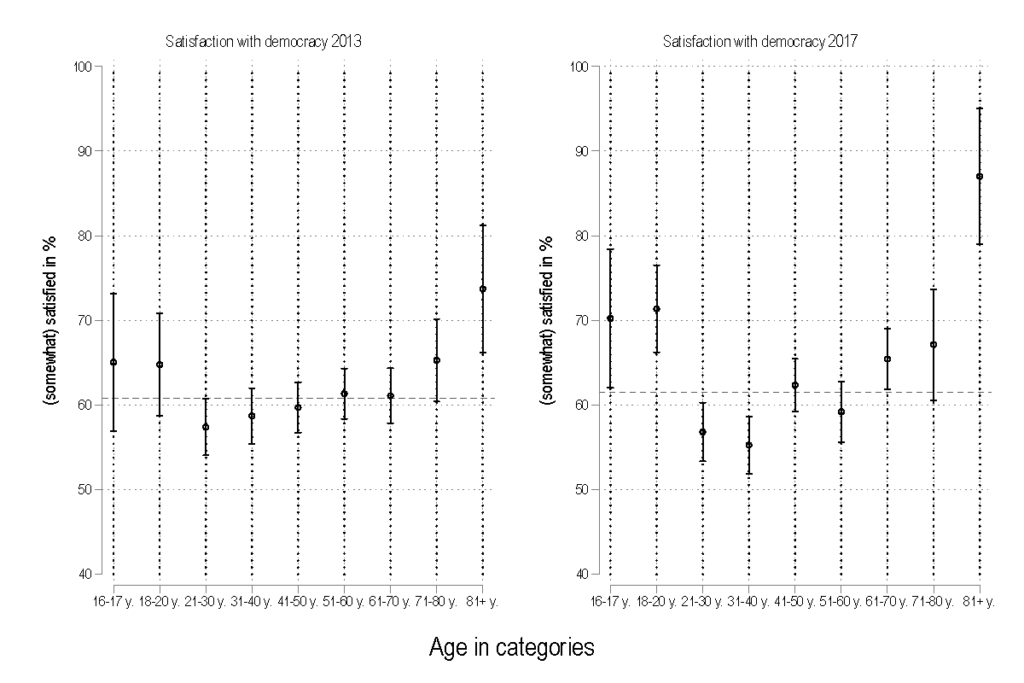What happens when the voting age is lowered to 16? A decade of evidence from Austria
Lowering the voting age to 16 is being discussed in several countries, but how do 16- and 17-year-olds compare to older first-time voters? In a new book chapter, Julian Aichholzer and Sylvia Kritzinger answer this question by looking at a decade of empirical evidence from Austria, where voting at 16 was introduced for national elections in 2007. Overall, they find that the evidence is encouraging for supporters of voting age reform, with younger citizens in general voting more than older first-time voters and expressing relatively high levels of trust in democratic participation. This has implications for policy-makers and contributes to an evidence-based debate about youth political engagement and electoral turnout.

Picture: Colin / Wikimedia Commons / CC BY-SA 4.0 licence
Why lower the voting age?
Policy-makers and researchers have long been concerned with young citizens’ engagement in politics and potential ways to foster greater political participation amongst them. Politicians, campaigners and political pundits have frequently put forward the idea of lowering the voting age to counter decreasing levels of electoral turnout especially among young voters. In theory, this measure could encourage involvement in politics at an earlier stage of life, while young people are still embedded in family and school surroundings, thus potentially boosting long-term involvement and participation. Currently, the idea of lowering the voting age is being discussed in several countries (e.g., in the US and UK), while others, like Malta, for example, just introduced a voting age reform in 2018. In the UK, voting for 16- and 17-year-olds has been introduced for devolved elections in Scotland and, more recently, in Wales.
In a new book chapter we assess the impact of this policy proposal in Austria, where the general voting age was lowered from 18 to 16 more than a decade ago, in 2007. For this, we rely on records from electoral lists as well as large-sample survey data by the 2013 and 2017 Austrian National Election Study (AUTNES) to compare 16- and 17-year-olds to cohorts of older voters. Our aim was to comprehensively assess the policy’s impact from a medium-term perspective by also taking into account potential contextual factors between elections.
What we find: higher turnout and trust in the political system
First, looking at official records from five elections (local, regional and national), we find that adolescent voters (16- to 17-year-olds) show relatively high turnout rates, on average. The gap in the level of turnout between this group of adolescents and older first-time voters (18- to 20-year-olds) ranges between +2.3% and +10.0%, meaning that 16- and 17-year-olds are more likely to turn out to vote than older first-time voters. In other words, turnout initially seems to decrease from age 18 onwards when young people ‘leave the nest’. In turn, the turnout level of 16- and 17-year-olds even approaches that of the total electorate. These findings generally corroborate earlier evidence reported by Zeglovits and Aichholzer.
Second, our analysis of survey data in 2013 suggests that political interest in politics per se seems to be somewhat lower among the youngest voters. However, over time these young voters became more interested in politics and electoral campaigns, with results that are similar to the population average in 2017. Looking at whether young citizens feel able to take an active role in politics, all first-time voters exhibit similar values as older voters, but, perhaps surprisingly, adolescent voters start their political career with a more optimistic picture of how politics works. The youngest group (16- to 17-year-olds) even exhibits the highest level of trust in the government to be responsive. Overall, first-time voters (aged 16–20) are also quite satisfied with the way democracy works, as do much older cohorts (70+ years old; see Figure 1 below).
Figure 1: Satisfaction with democracy among different age groups in Austria

In general, we also find, in-keeping with expectations, that party attachment (i.e., feeling close to a specific party) is generally higher among older voters, although the rates among all first-time voters (16–17 and 18–20 year-olds) have become more similar to each other over time. However, at least in 2017, 16- to 17-year-old voters seemed to have a below average probability to vote ‘correctly’, i.e., they are less likely to vote for a party that is closest in ideological terms to their own views.
Our study on the Austrian case provides a comprehensive and medium-term assessment of political involvement among adolescent voters aged 16–17. Overall, the level of turnout is generally higher among 16- to 17-year-olds (compared to 18- to 20-year-olds) and similar to the electorate’s average (and here in particular amongst the 16-year-olds), as evidenced by official records from electoral lists. Results on ‘political maturity’ are more mixed but still very positive, particularly when observed from a medium-term perspective. Importantly, in most instances we find that the youngest group does not differ significantly from older first-time voters (18–20), and in some instances they even outperform them.
Initially, the picture in 2013 suggested a somewhat more pessimistic picture of adolescent voters. However, with the two groups becoming more alike in the subsequent election, the picture turned positive again in 2017. Do our results thus already indicate ‘voting at 16’ to be the ‘new normal’ after the 2007 voting age reform? Or is this the effect of a contested election in 2017? It is safe to say that the 2017 elections showed a greater level of politicisation and high salience that might have strongly mobilised all voters, young and old alike, resulting also in an increase in turnout. In general, though the criticism that often accompanies proposals to lower the voting age to 16 – for example, that adolescents will not engage in elections – did not manifest. Rather, they show that adolescents play an active part in political life, if they are allowed to.
Policy recommendations from Austria
We would like to close this blog article by summarising why and how Austria lowered the voting age in the first place. In Austria, the electoral reform which led to voting at 16 was clearly a top-down process initiated by the main parties. In particular, the idea was strongly promoted by the left-wing parties, the governing Social Democratic Party (SPÖ) as well as The Greens (in opposition). Observers of the reform noted that it came about because of a deal whereby the SPÖ agreed to introduce absentee voting (Briefwahl), which was proposed by its coalition partner, the Austrian People’s Party (ÖVP), in exchange for a decrease in the voting age. Eventually, a general voting age of 16 was implemented in 2007 as part of a more extensive electoral reform that included other novel measures. In other countries, the lowering of the voting age might be more viable within the context of more general electoral reforms.
It is also worth mentioning that the voting age reform in Austria was accompanied by several measures for the youngest voters, such as awareness-raising campaigns. Moreover, civic and citizenship education was implemented as a mandatory cross-curricular educational principle. This is important since other scholarly work suggests that civic and political education plays an important role in preparing young people for active participation in political life. We thus advise policy-makers to complement any lowering of the voting age with measures in school education to ensure positive long-term effects.
This article gives the views of the authors, and not the position of Democratic Audit. It draws on their chapter entitled “Voting at 16 in practice: A review of the Austrian case” which appeared in: Eichhorn, Jan & Bergh, Johannes (eds.) (2020). Lowering the Voting Age to 16 – Learning from Real Experiences Worldwide, published by Palgrave Macmillan.
About the authors

Julian Aichholzer is a Post-Doc researcher at the Department of Government at the University of Vienna and is affiliated with the Austrian National Election Study (AUTNES). His research interests include political attitudes and voting behaviour, political psychology, and survey research.

Sylvia Kritzinger is Professor of Methods in the Social Sciences at the Department of Government at the University of Vienna. She is deputy director of the Vienna Center for Electoral Research (VieCER) and one of the project leaders of the Austrian National Election Study (AUTNES). Her research focuses on political behaviour, electoral research, democratic representation, political participation and quantitative methods.





 Democratic Audit's core funding is provided by the Joseph Rowntree Charitable Trust. Additional funding is provided by the London School of Economics.
Democratic Audit's core funding is provided by the Joseph Rowntree Charitable Trust. Additional funding is provided by the London School of Economics.